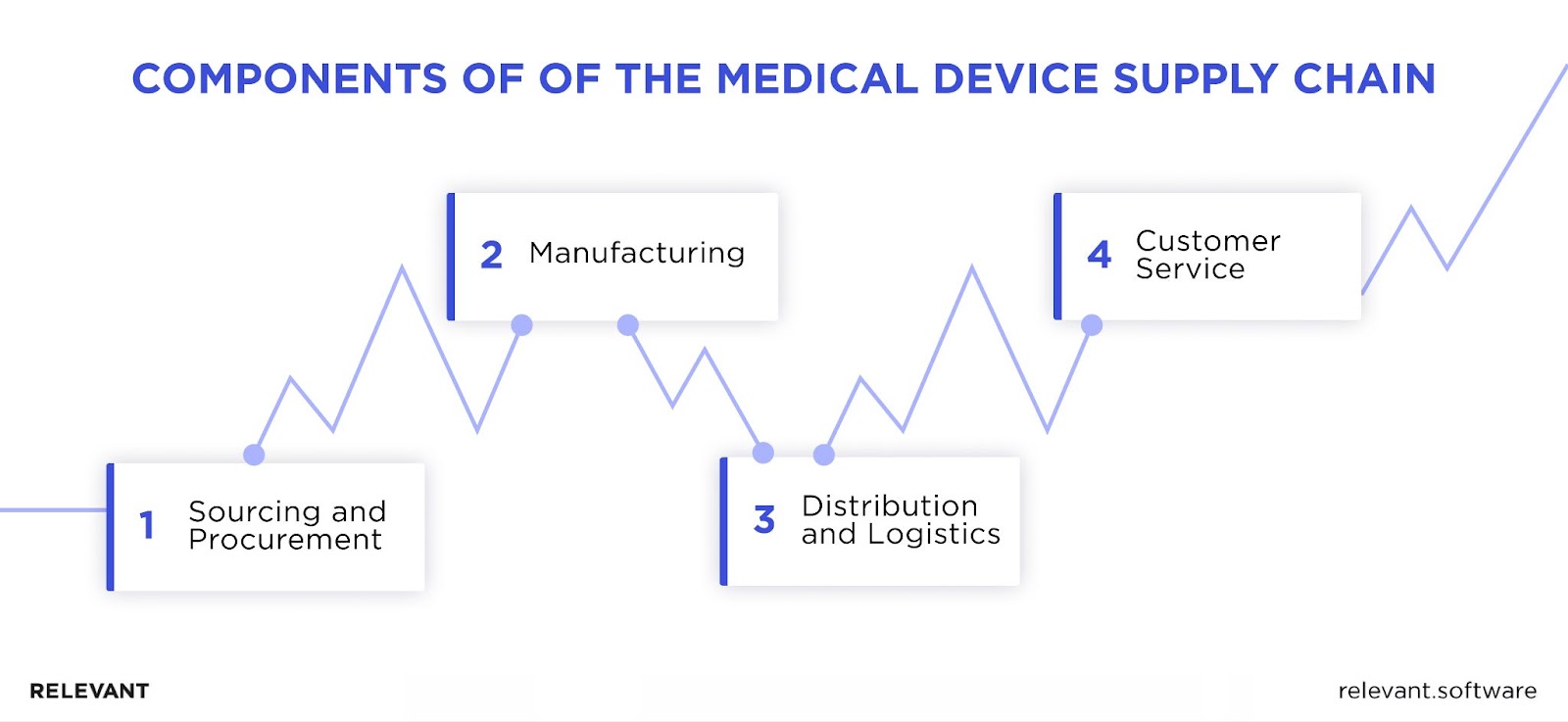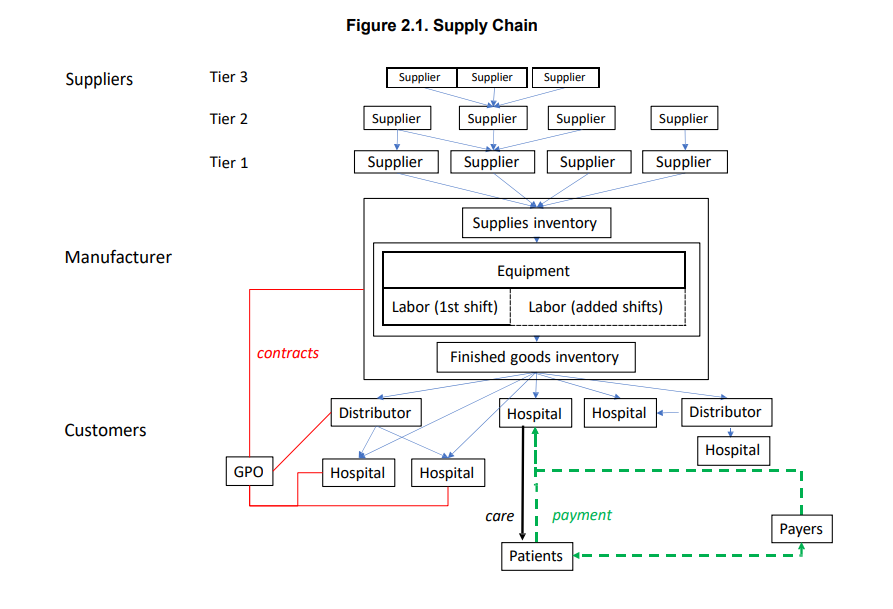Medical Device Supply Chain: The Backbone, Bottlenecks, and Breakthroughs
Updated: June 4, 2025
Let’s take a moment to talk about supply chains, specifically in healthcare. Most of what happens in these complex networks hums quietly in the background of the medical facilities. But only when something goes wrong– think back to those nail-biting moments during the COVID-19 lockdowns – the medical device supply chain suddenly takes center stage. We have all witnessed the skyrocketing demand for medical supplies as prices skyrocket and items become scarce.
Jump to March 2023, and here’s a bit of a shocker: the Health Industry Distributors Association (HIDA) has reported that a whopping 93% of healthcare providers are still struggling with product shortages. Even more surprising? These current shortages are broader and sneakier than what we experienced at the peak of the pandemic.

We provide companies with senior tech talent and product development expertise to build world-class software. Let's talk about how we can help you.
Contact usNow, here’s the most interesting part: quite a few big names in healthcare seem to be snoozing on the massive potential of digital tech for their supply chains. It’s high time we all get hip to how technology is turbocharging the medical device supply chain.
Table of Contents
The Medical Device Supply Chain: The Importance for Healthcare
Think of any healthcare setting – a bustling city hospital, a tranquil elder care facility, or a lively local clinic. There, silently at its core, the supply chain pulsates quitely. It ensures that life-saving tools, from simple syringes to complex surgical instruments, reach the hands that need them most. Let’s dive into the bedrock principles that hold up the medical device supply chain.
1. Quality Control and Consistency: Any disruption or mismanagement in this chain can lead to compromised product quality. Quality control isn’t a mere checkpoint; it’s a continuous process. Ensuring that devices adhere to stringent standards is critical, as it directly affects patient safety and treatment outcomes.
2. Timely Delivery: In medical emergencies, ‘tomorrow’ might be too late. An efficient supply chain guarantees that devices, especially those pivotal in critical care, are available on demand. Hospitals can’t afford stock-outs of essential devices, and the supply chain ensures they don’t have to.
3. Cost Management: An optimized supply chain reduces unnecessary overheads and wastages. By keeping costs in check, healthcare institutions can potentially offer treatments at more affordable rates, making healthcare accessible to more individuals.
4. Innovation and Advancement: The supply chain also plays a role in feedback loops. Manufacturers and innovators rely on feedback from end-users to refine their products. An open channel between providers and producers facilitates rapid improvements and advancements in device technology.
5. Regulatory Compliance: Navigating the myriad of global medical regulations is no small feat. The supply chain ensures that devices not only reach their intended destinations but also adhere to local and international regulatory standards.
In essence, the medical device supply chain does more than move products—it ensures the heartbeat of modern medicine remains strong and steady. By understanding its complexities, we gain a deeper appreciation for the systems that keep our healthcare environments running seamlessly.
Core Elements of the Medical Device Supply Chain
Navigating the medical device supply chain isn’t just about moving products from Point A to Point B. It’s a complex interplay of processes and players, ensuring medical tools safely and efficiently reach their destination. Let’s dissect the four pivotal elements that form the backbone of this essential system.

- Sourcing and Procurement: This is where it all begins. Before a medical device can be manufactured, the raw materials and components have to be in place. But this isn’t about merely finding suppliers; it’s about identifying those who maintain rigorous quality standards and can consistently meet demand. Strategic sourcing involves meticulous research, negotiation, and relationship-building. In this realm, the keyword is “partnership” because dependable suppliers become vital allies in delivering impeccable products.
- Manufacturing: Transforming those raw materials into life-saving medical devices is no small task. Manufacturing in the medical domain requires a perfect blend of precision, innovation, and adherence to strict regulatory standards. Each device, whether it’s a cutting-edge surgical robot or a humble blood pressure monitor, undergoes rigorous testing and quality checks. These ensure functionality, reliability, and, most crucially, patient safety.
- Distribution and Logistics: Manufactured devices don’t save lives if they’re sitting in a warehouse. Distribution and logistics ensure that every product reaches its intended location, be it a bustling city hospital or a remote rural clinic. It’s more than just transportation; it’s about maintaining product integrity. Devices need to be stored and shipped under specific conditions, especially when it comes to temperature-sensitive items or those requiring sterile environments. Efficient logistics translates to timely deliveries, minimizing the gap between need and availability.
- Customer Service: The journey doesn’t end once the device reaches its destination. Customer service steps in to bridge any gaps between the product and its end-users. Whether it’s troubleshooting, offering training, managing returns, or addressing concerns, this arm of the supply chain ensures that healthcare professionals can make the most of each device. In essence, customer service works to amplify the value of the product, fostering trust and reliability.

Source: ASPE
NOTES: Blue arrows show material transport. Red dotted lines represent contracts. Green dashes signal patient care payments. GPO stands for group purchasing organization.
Challenges Faced in the Medical Device Supply Chain
In the dynamic sphere of the medical device supply chain, staying ahead means constantly evaluating potential hurdles. After all, acknowledging challenges is the first step to overcoming them. Here’s a closer look at four critical areas in the medical device supply chain that could use some fine-tuning.
Regulatory Compliance
Navigating the world of medical devices isn’t just about innovation; it’s about meticulous adherence to regulations and best manufacturing practices. Every step, be it design, production, storage, or shipping, has its set of rules to follow. The FDA, for example, is more than just a governing body in the US; it sets the gold standard in ensuring medical devices are safe and effective. However, its standards may differ considerably from those in Europe, Asia, or other regions.
To add another layer, each device out there needs a unique identifier – a UDI. This becomes especially challenging when dealing with distributed supply chains, where components shuffle between facilities before becoming a finished product.
Inventory Management
In the realm of medical devices, efficient inventory management can make the difference between a successful procedure and a medical emergency. Predicting demand is a delicate balancing act. Overstocking may lead to wastage, especially for products with limited shelf lives, while understocking can compromise patient care. The stakes are high, and so is the pressure.
Hospitals and clinics rely on just-in-time deliveries to maintain lean inventories, but this necessitates impeccable demand forecasting and responsive supply chains. Efficient inventory management, therefore, isn’t just a logistical concern; it’s central to delivering consistent, high-quality patient care.

Supply Chain Visibility
That’s the challenge faced by stakeholders in the medical device supply chain when there’s a lack of end-to-end visibility. When each stage of the supply chain—from manufacturing to delivery—cannot be monitored or traced, inefficiencies creep in. Products can get delayed, lost, or compromised. A transparent supply chain minimizes risks, ensures timely deliveries, and fosters trust among all participants. In today’s connected age, anything less than complete visibility can mean missed opportunities and increased liabilities.
Technological Integration
As new systems and solutions emerge, their integration into existing infrastructures becomes a pivotal concern. It’s not merely about adopting the latest hospital supply chain software or tool but ensuring it seamlessly meshes with the current ecosystem. Incompatibility issues can lead to data silos, process disruptions, and reduced efficiency. Moreover, with the stakes so high in healthcare, any technological misstep can have significant repercussions. Thus, while advancements beckon, their integration necessitates careful planning, training, and, often, a mindset shift across the supply chain spectrum.
Solutions to Overcome Medical Devices Supply Chain Issues
As complex as the challenges may be in the medical device supply chain, the solutions are not only practical but transformative. Here’s how technology, inventory management, and collaboration with third-party providers can reshape the landscape.
Adoption of Technology
The pandemic has done more than just push us to adapt; it’s driven the healthcare sector to innovate. We’re seeing organizations break down old barriers and embrace new technologies to overhaul supply chain management. No more data silos or disconnected systems – we’re talking about tools that link supply chains with electronic health records (EHR) and more.
- IoMT (Internet of Medical Things): Devices connected via IoMT can relay real-time data, helping in proactive maintenance, tracking, and quality assurance. GVR foresees RFID technology leading in IoMT healthcare solutions over the next six years, with the use of RFID tags for medication, asset tracking, and innovations like smart pills and beds fueling growth.
- AI (Artificial Intelligence): AI can predict demand, optimize routes, and enhance decision-making by analyzing vast data sets faster than any human ever could. A McKinsey medical device supply chain case study highlighted that early AI adopters in supply-chain management slashed logistics costs by 15%, boosted inventory by 35%, and enhanced service levels by 65% compared to their less tech-forward peers.
- Blockchain: In the near future, blockchain solutions, enhanced by AI and IoT, promise to boost interoperability and data flow, elevating supply chain performance. It ensures security, trust, visibility, and decentralized tracking for global medical products, preventing counterfeits and damage. It also authenticates, cuts costs, and updates on product status from manufacturer to end-user.
- Cloud Computing: The healthcare cloud market is on track to jump from $39.4 billion in 2022 to $89.4 billion by 2027. That’s not all — McKinsey suggests it might unveil a jaw-dropping value between $100-170 billion by 2030. Transferring healthcare supply chain procedures and information into cloud-based enterprise resource planning (ERP) systems fuels acceleration, adaptability, growth, and clarity. And with its usage for AI, ML, Big Data, and IoT, embracing the cloud isn’t just a trend—it’s fueling groundbreaking innovation, shaping better patient care, and steering decisive, data-backed choices.
According to the Harvard Business Review, digitally overhauling the supply chain can cut process costs in half and boost revenue by 20%; and this holds true even in the hospital setting. With digital supply networks and cloud-based technologies, healthcare providers can now tie together everything from procurement to patient care.
It’s all about standardizing, automating, and streamlining processes to not just cut costs but enhance patient outcomes. Together, these technologies can elevate the supply chain, making it more agile, transparent, and resilient to challenges.
Implementing Robust Inventory Management Systems
Advanced inventory management systems use historical data to foresee what you’ll need, sidestepping those annoying stockouts that can mess up patient care, and also dodging overstocks that simply drain your resources.
What’s the win here? Think about efficient inventory turnover, less waste, smartly optimized storage costs, and the confidence that medical devices are always ready when needed. Now, let’s talk about the real deal – how do we manage this inventory? Well, right now, two main systems are in the spotlight.
- Enterprise Resource Planning System (ERP): It’s everywhere, this software suite that gathers all sorts of information about the supply chain. But here’s the catch: it’s as rigid as they come and doesn’t play well with the unique needs of a medical institution. And don’t even think about it unless you’re a big international player. Read more about the peculiarities of healthcare EPR here.
- Custom System: This is where it gets interesting. Recognizing the stiffness of ERP, custom systems break things down, managing the supply chain in bite-sized pieces. Think of different departments like surgery or urgent care – all handled separately.
Why does this matter? Simple: it’s all about cutting those costs. Each “compartment” can get exactly what it needs, no more, no less. And guess what? It’s working so well that it’s becoming the go-to approach in healthcare. But here’s the cherry on top: this niche approach isn’t just about saving bucks; it’s about putting patients first. It’s all about giving them what they need without breaking the bank.
Partnering with 3PL Providers
Third-party logistics (3PL) providers can be the ace up a supply chain’s sleeve. With their specialized expertise, infrastructure, and technology, they can streamline logistics operations. Whether it’s medical device warehousing, transportation, or last-mile delivery, 3PLs bring efficiency, scalability, and flexibility to the table. Partnering with them allows medical device companies to focus on their core competencies while ensuring the supply chain works with impeccable efficiency.
The Role of Sustainability in the Medical Device Supply Chain
In today’s landscape where sustainability has transitioned from a trending term to a core business imperative, medical device supply chain management stands at a unique crossroads. Embracing sustainable practices isn’t just a nod to environmental responsibility; it’s central to ensuring lasting business success and maintaining the trust of patients.
As we delve into the nuances of medical device supply chain trends, it becomes evident that these devices carry a responsibility far beyond their primary function. They must be innovative, useful, and above all, a testament to sustainable consumption. Here’s how:
- Material Selection: By prioritizing bio-compatible, recyclable, or sustainably-sourced materials, the med tech supply chain can make strides in diminishing its environmental impact.
- Energy-Efficient Manufacturing: Through the lens of medical device supply chain consulting, green energy adoption and streamlined production processes emerge not only as solutions for reduced emissions but also avenues for long-term cost efficiency.
- Waste Reduction: From the assembly line to the end product’s packaging and eventual disposal, there’s a story of waste minimization and recycling waiting to be told. And with the right healthcare supply chain software, this narrative becomes more actionable, leading to a profound reduction in the supply chain’s ecological footprint.
- Transport and Logistics: As the gears of the supply chain turn, consolidating shipments, reimagining transportation routes, and adopting greener modes of transport can significantly cut down on carbon emissions.
Furthermore, as the medical device sustainability supply chain continues to evolve, its stakeholders – from manufacturers to end-users – are becoming more eco-conscious. The emphasis on sustainability isn’t merely a moral compass guiding the industry; it’s a shrewd business strategy. The medical devices of tomorrow will be celebrated not just for their groundbreaking features but for the resilient spirit that underpins their journey from conception to delivery.
In conclusion
In today’s medical device supply chain environment, healthcare software development does not merely play a side role – it takes center stage. And that’s where our team at Relevant steps in.
At Relevant, we recognize that supply chain software development isn’t about building one-size-fits-all tools. It’s about developing solutions that perfectly fit your unique needs. The rigorous demands of the medical sphere require a tailored approach, one that addresses not only today’s challenges but also foresees those of tomorrow. Here’s a glimpse into what we bring to the table:
- Healthcare IT consulting: We provide expert guidance on integrating and optimizing technology solutions to enhance medical device supply chain management.
- Customization: Be it regulatory intricacies or the nuances of inventory management, our software is fine-tuned to align seamlessly with your organizational objectives.
- Integration: Our software is crafted to blend flawlessly with your existing technologies, guaranteeing uninterrupted data exchange and smooth operations.
- Security and Compliance: For us, ensuring unwavering data integrity and compliance in the medical device supply chain isn’t an add-on; this is a basis.
- Data Analytics and AI: At Relevant, we employ data analytics and AI to help you make smarter choices. We turn overwhelming data into insights that drive action, shaping strategies that sense demand waves and evaluate risks even before they emerge.
Our services are grounded on earnest collaboration with you. Why? Because we believe in building solutions that are robust yet resonate with customer needs and sensibilities. Contact us and let’s supercharge your supply chain together.
FAQ
Our core services:
Do you want a price estimate for your project?
Do you know that we helped 200+ companies build web/mobile apps and scale dev teams?
Let's talk about your engineering needs.
Write to us











